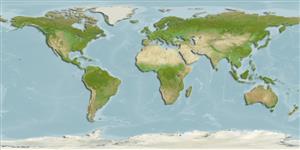Gonactinia prolifera (Sars, 1835)
Storey anemone| Native range | All suitable habitat | Point map | Year 2050 |

|
| This map was computer-generated and has not yet been reviewed. |
| Gonactinia prolifera AquaMaps Data sources: GBIF OBIS |
Upload your photos
Google image |
No photo available for this species.No drawings available for Gonactiniidae.
Google image |
No photo available for this species.
Classification / Names Common names | Synonyms | CoL | ITIS | WoRMS
Anthozoa | Actiniaria | Gonactiniidae
Environment: milieu / climate zone / depth range / distribution range Ecology
Sessile; depth range 1 - 100 m (Ref. 87801). Subtropical
Distribution Countries | FAO areas | Ecosystems | Occurrences | Introductions
Amphi-Atlantic, Southern Pacific and the Mediterranean: New Zealand and Chile.
Length at first maturity / Size / Weight / Age
Maturity: Lm ? range ? - ? cm
This species is capable of transverse fission; separation of sexes (Ref. 87801). Known from infra- and circalittoral zones (Ref. 85338), at depths of 1 to 100 m (Ref. 87801). Found on rocky and biogenic substrates such as shells, worm tubes, algae, etc. It is observed to detach from the substratum when disturbed and it is capable of creeping and swimming with its moving tentacles and OD head (Ref. 87801). Solitary (Ref. 2377).
Life cycle and mating behavior Maturity | Reproduction | Spawning | Eggs | Fecundity | Larvae
Members of the class Anthozoa are either gonochoric or hermaphroditic. Mature gametes are shed into the coelenteron and spawned through the mouth. Life cycle: The zygote develops into a planktonic planula larva. Metamorphosis begins with early morphogenesis of tentacles, septa and pharynx before larval settlement on the aboral end.
Main reference
References | Coordinator | Collaborators
Vafidis, D. 2010. (Ref. 85338)
IUCN Red List Status (Ref. 130435)
CITES status (Ref. 108899)
Not Evaluated
CMS (Ref. 116361)
Not Evaluated
Threat to humans
Human uses
| FishSource |
Tools
More information
Age/Size
Growth
Length-weight
Length-length
Morphology
Larvae
Abundance
Growth
Length-weight
Length-length
Morphology
Larvae
Abundance
Internet sources
BHL | BOLD Systems | CISTI | DiscoverLife | FAO(Publication : search) | Fishipedia | GenBank (genome, nucleotide) | GloBI | Gomexsi | Google Books | Google Scholar | Google | PubMed | Hexacorallians of the World | Tree of Life | Wikipedia (Go, Search) | Zoological Record
Estimates based on models
Preferred temperature
(Ref. 115969): 10.4 - 15.4, mean 12 (based on 62 cells).
Price category
(Ref. 80766):
Unknown.


